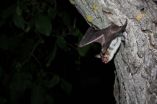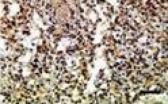(Press-News.org) The panel discussion is getting heated -- but what exactly is in the new proposed law that the experts on TV are arguing about so vigorously? Up until now, spontaneous questions such as these that arise during a program had to be clarified through a viewer's own research on the Internet.
If it's up to researchers at the Fraunhofer Institute for Intelligent Analysis and Information Systems IAIS in Sankt Augustin, Germany, viewers will no longer have to look up such additional information in the future. In the project "LinkedTV", the institute is working with eleven partners from seven countries on a new television concept. "We want to seamlessly combine television and the Internet so that viewers can directly access background information about the current program during the show, without having to spend a lot of time and effort themselves in searching for it," explains project manager Heike Horstmann. Some channels are already taking steps toward such a linking of TV and the Web -- but this requires a relatively high amount of effort by personnel: The editorial staff has to scour the Internet or the broadcaster archive for suitable material and provide the links to the broadcast manually.
Software Accelerates the Editorial Team's Research
The project partners have developed intelligent software which will greatly simplify this laborious work in the future. The solution scans the contents of a show prior to its broadcast via speech analysis and image processing for topic-related content from the Web. Since the software provides a great number of unfiltered hits and semantic links, the researchers have developed methods to narrow down the results according to cer-
tain criteria. "For example, content will be displayed only if it complies with laws for the protection of minors and for which the copyright is no problem," Horstmann explains. The editorial team adds the final touches, checking suggested content for relevance and eliminating any duplications from the hit list.
Parallel to the broadcast, the viewer then finds information sorted according to topic for each chapter of a TV program. If desired, he or she can specify filter criteria that determine which content is displayed – defining topics of particular interest or hiding results for specific content. In addition, the software is also capable of learning and adjusts the offer of information to the user's behavior. "If the viewer repeatedly accesses the weather report or information on a particular topic, for instance, this content will be displayed in a prioritized fashion," says Horstmann. The viewer can view both broadcast and additional content directly on the screen of an Internet-capable television or on another end device with Web access, such as a tablet or laptop. The best approach would be to use two screens which are synchronized with each other in parallel. Generally, the show then runs on the television, while further content is displayed on the "second screen." "The user controls both devices via the second screen. He can then, for example, interrupt the program on the television to inform himself of a particular detail via the tablet," explains Horstmann.
To give a practical idea of how linked television might look, IAIS researchers and their project partners have enriched two real formats – a newscast by Rundfunk Berlin-Brandenburg and a documentary series of the Dutch TV station AVRO – with additional virtual content. The results will be presented this year at several professional events – including IBC 2014 in Amsterdam.
INFORMATION:
Linking television and the Internet
2014-07-23
ELSE PRESS RELEASES FROM THIS DATE:
Bats use the evening sky's polarization pattern for orientation
2014-07-23
This news release is available in German.
Animals can use varying sensory modalities for orientation, some of which might be very different from ours. Some bird species for example take the polarization pattern produced by sunlight in the atmosphere to calibrate their orientation systems. Now researchers from the Max Planck Institute for Ornithology in Seewiesen, Germany, and Queen's University Belfast have discovered with colleagues from Israel that a night active mammal, the greater mouse-eared bat, has the capability to orient using polarized light. These bats ...
Rising temperatures hinder Indian wheat production
2014-07-23
Geographers at the University of Southampton have found a link between increasing average temperatures in India and a reduction in wheat production.
Researchers Dr John Duncan, Dr Jadu Dash and Professor Pete Atkinson have shown that recent warmer temperatures in the country's major wheat belt are having a negative effect on crop yield. More specifically, they found a rise in nighttime temperatures is having the most impact.
Dr Jadu Dash comments: "Our findings highlight the vulnerability of India's wheat production system to temperature rise, which is predicted to ...
A crystal wedding in the nanocosmos
2014-07-23
Researchers at the Helmholtz-Zentrum Dresden-Rossendorf (HZDR), the Vienna University of Technology and the Maria Curie-Skłodowska University Lublin have succeeded in embedding nearly perfect semiconductor crystals into a silicon nanowire. With this new method of producing hybrid nanowires, very fast and multi-functional processing units can be accommodated on a single chip in the future. The research results will be published in the journal Nano Research.
Nano-optoelectronics are considered the cornerstone of future chip technology, but the research faces major ...
Intestinal parasites are 'old friends,' researchers argue
2014-07-23
Intestinal parasites such as tapeworms, hookworms and a protist called Blastocystis can be beneficial to human health, according to a new paper that argues we should rethink our views of organisms that live off the human body.
To prove the point, paper co-author Julius Lukeš even ingested three developmental stages of a large species of tapeworm called Diphyllobothrium latum. After more than a year with the tapeworms, which might have grown to be as long as four metres each by now, he says he feels fine.
"I knew there was no risk," he says.
Lukeš, a senior fellow ...
Toward an oral therapy for treating Alzheimer's disease: Using a cancer drug
2014-07-23
Currently, no cure exists for Alzheimer's disease, the devastating neurological disease affecting more than 5 million Americans. But scientists are now reporting new progress on a set of compounds, initially developed for cancer treatment, that shows promise as a potential oral therapy for Alzheimer's. Their study appears in ACS' Journal of Medicinal Chemistry.
Carlo Ballatore, Kurt R. Brunden and colleagues explain that in a healthy brain, the protein known as tau binds to and stabilizes microtubules, which are cellular components made of protein inside cells. Microtubules ...
Anti-pain agent shrinks oral cancers, leaves healthy tissues alone
2014-07-23
SAN ANTONIO (July 22, 2014) — Mouse models of human oral cancer treated with an agent called capsazepine showed dramatic tumor shrinkage without damage to surrounding tissues, researchers from the School of Dentistry and School of Medicine at The University of Texas Health Science Center at San Antonio found. The Health Science Center has claimed intellectual property on results of the study, which is described in the journal Oral Oncology.
Late diagnosis, low survival
Oral squamous cell carcinoma is the eighth most common cancer in the U.S. with 40,000 new cases and ...
HIV clinic-based audio project emphasizes the power of patient voices
2014-07-23
(MEMPHIS, Tenn. – July 22, 2014) The voice on the recording was low and calm as the speaker recounted the telephone call that brought the news he was infected with the human immunodeficiency virus (HIV) that causes AIDS: "My heart just stopped for a little bit and next thing you know I was on the floor flat on my face boohooing, crying like a baby."
Yet the message was hopeful when the recording ended less than 10 minutes later. "Don't feel like this is the end of you . . . because it is just God setting you up for something greater," the anonymous speaker tells an unseen ...
Chinese scientists search for evidence of dark matter particles with new underground PandaX detector
2014-07-23
The new PandaX facility, located deep underground in the southwestern Chinese province of Sichuan, hosts a large liquid-xenon detector designed to search for direct evidence of dark matter interactions with the nuclei of xenon and to observe 136Xe double-beta decay.
The detector's central vessel was designed to accommodate a staged target volume increase from an initial 120 kg (stage I) to 0.5 t (stage II) and ultimately to a multi-ton scale.
The technical design of the PandaX facility and detector is outlined in a new paper co-authored by Ji Xiangdong, of the Institute ...
High matrix metalloproteinase-9 expression induces microangiogenesis after cerebral infarction
2014-07-23
Basement membrane degradation and blood-brain barrier damage appear after cerebral infarction, severely impacting neuronal and brain functioning. Matrix metalloproteinase-9 is able to degrade the major components of the basement membrane around cerebral blood vessels and to mediate extracellular matrix remodeling. Therefore, Dr. Huilian Hou and colleagues from the First Affiliated Hospital of Medical School of Xi'an Jiaotong University, China induced cerebral infarction in stroke-prone spontaneously hypertensive rats by intragastric administration of high-sodium water (1.3% ...
Ischemic preconditioning for cerebral infarction: Is it related to upregulation of VEGF?
2014-07-23
Neuroprotection by ischemic preconditioning has been confirmed by many studies, but the precise mechanism remains unclear. In a study released in the Neural Regeneration Research (Vol. 9, No. 11, 2014), Dr. Yong Liu and co-workers from Tongji Hospital Affiliated to Tongji Medical College, Huazhong University of Science and Technology, China performed cerebral ischemic preconditioning in rats by simulating a transient ischemic attack, and explored the mechanism underlying the neuroprotective effect of ischemic preconditioning. Researchers discovered that the infarct volume ...





